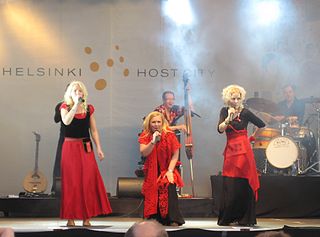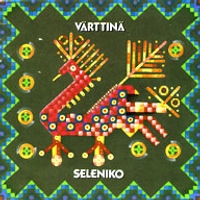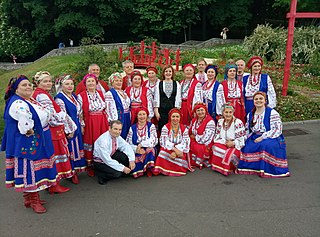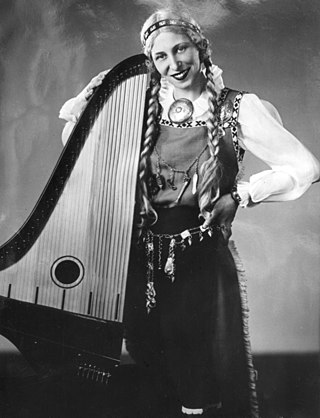Related Research Articles

A kantele or kannel is a traditional Finnish and Karelian plucked string instrument (chordophone) belonging to the south east Baltic box zither family known as the Baltic psaltery along with Estonian kannel, Latvian kokles, Lithuanian kanklės and Russian gusli.
The music of Finland can be roughly divided into folk music, classical and contemporary art music, and contemporary popular music.
Nordic folk music includes a number of traditions of Nordic countries, especially Scandinavian. The Nordic countries are Iceland, Norway, Sweden, Denmark and Finland.

Music of Russia denotes music produced from Russia and/or by Russians. Russia is a large and culturally diverse country, with many ethnic groups, each with their own locally developed music. Russian music also includes significant contributions from ethnic minorities, who populated the Russian Empire, the Soviet Union and modern-day Russia. Russian music went through a long history, beginning with ritual folk songs and the sacred music of the Russian Orthodox Church. The 19th century saw the rise of highly acclaimed Russian classical music, and in the 20th century major contributions by various composers such as Igor Stravinsky as well as Soviet composers, while the modern styles of Russian popular music developed, including Russian rock, Russian hip hop and Russian pop.

Gusli is the oldest East Slavic multi-string plucked instrument, belonging to the zither family, due to its strings being parallel to its resonance board. Its roots lie in Veliky Novgorod in Novgorodian Republic. It may have a connection to the Byzantine form of the Greek kithara, which in turn derived from the ancient lyre, or might have been imported from Western and Central Europe during the Middle Ages, when the zither had immense popularity. It has its relatives in Europe and throughout the world: kantele in Finland, kannel in Estonia, kanklės in Lithuania, kokles in Latvia, Zither in Germany, citera in the Czech Republic, psalterium in France and so on... Furthermore, the kanun has been found in Arabic countries, and the autoharp, in the United States. It is also related to such ancient instruments as Chinese gu zheng, which has a thousand-year history, and its Japanese relative koto. A stringed musical instrument called guslim is listed as one of the Me in ancient Sumer.

Värttinä is a Finnish folk music band that started as a project by Sari and Mari Kaasinen in 1983 in the village of Rääkkylä, in Karelia, the southeastern region of Finland. Many transformations have taken place in the band since then. Värttinä shot into fame with the release of their 1991 album Oi Dai. As of 2009, the band consists of three lead female vocalists supported by three acoustic musicians. The vocalists sing in the Karelian dialect of the Finnish language.
Hedningarna is a Swedish, and for some years partly Finnish, folk music band that mixes electronics and rock with elements from old Scandinavian folk music. Their music features yoik or juoiggus, a traditional Sami form of song.
Sanna Kurki-Suonio is a Finnish singer, kantele player and composer in the contemporary folk / neo-folk music genre. She is most well known for her work with the band Hedningarna, which extended over eight years between 1991 and 1999. She was also a founding member of the group Loituma.

Seleniko is the fourth album by Finnish folk group Värttinä, and second after they re-formed in 1990, released in Finland by Spirit and Polygram Finland in 1992. It immediately reached the top of the European World Music radio charts, and remained there for 3 months. In 1993, it was released by Music & Words in Benelux and Xenophile Records in the United States. NorthSide re-released the album in 1998 in the United States.

Vihma is Värttinä's 7th album, released in 1998. It is primarily pop- and rock-influenced Finnish folk music. However, three tracks also include Tuvan throat singing.

iki is Värttinä's 11th album, released in 2003. It continues Värttinä's trend of having more original compositions, while retaining a folk influence in the songs and their style.

Traditional music of Karelia is a form of music performed among Karelian people. It has been less influenced by Germanic elements than traditional Finnish music, which is why many Finnish musicians and other creators have used it as source of inspiration. Like other Baltic Finnic people Karelians have performed rune singing. Unlike Finland and like the neighboring Ingrian music of Russia, however, Karelia is also home to musical laments. The kantele is a popular instrument in Karelia as well as throughout Finland.

Kokle or historically kokles (kūkles) is a Latvian plucked string instrument (chordophone) belonging to the Baltic box zither family known as the Baltic psaltery along with Lithuanian kanklės, Estonian kannel, Finnish kantele, and Russian krylovidnye gusli. The first possible kokles related archaeological findings in the territory of modern Latvia are from the 13th century, while the first reliable written information about kokles playing comes from the beginning of the 17th century. The first known kokles tune was notated in 1891, but the first kokles recordings into gramophone records and movies were made in 1930s. Both kokles and kokles playing are included in the Latvian Culture Canon.

Tales Along This Road is the third studio album by Finnish folk metal band Korpiklaani. It was released on 21 April 2006 by Napalm Records.

Loituma Girl is a Flash animation set to a scat singing section of the Finnish song "Ievan polkka," sung by the Finnish quartet Loituma on their 1995 debut album Things of Beauty. It appeared on the Internet in late April 2006 and quickly became popular. The animation consists of four frames showing the Bleach anime character Orihime Inoue twirling a leek, set to a 27-second loop from the song. The part of the song which is included in the meme is improvisation by Hanni-Mari Autere which are totally random.
"Ievan polkka" is a Finnish song with lyrics printed in 1928 and written by Eino Kettunen to a traditional Finnish polka tune. The song is sung in an Eastern Savonian dialect spoken in North Karelia. It is sung from the point of view of a young man, about a woman called Ieva who sneaks out and dances the polka with him all night. The song is often mistaken for a traditional folk song, but the lyrics by Eino Kettunen are still under copyright. Later, a scat singing version of the song by the band Loituma was incorporated into the viral animation Loituma Girl. In 2007, the song was brought into worldwide popular culture through a cover sung by Hatsune Miku, with Otomania arranging the music and providing Miku's voice manipulation.

My Kantele is the second EP by Finnish heavy metal band Amorphis, released in 1997. It is not to be confused with the song "My Kantele" from the album Elegy, which is not on this compilation, although the title is still used as it contains the acoustic version of "My Kantele" and four previously unreleased songs. The song "My Kantele" is a traditional Finnish song from the 1840 collection Kanteletar, sung by Loituma.

Ukrainian folk music includes a number of varieties of traditional, folkloric, folk-inspired popular music, and folk-inspired European classical music traditions.

Ulla Kyllikki Katajavuori-Koskimies was a Finnish musician who played the traditional Finnish kantele, performing from the 1930s to the 1990s. One of her recordings is the Karelian folk song Konevitsan kirkonkellot.
References
- ↑ "Web Search interest: Loituma, folk music - Worldwide, 2004 - present". Google Trends. Retrieved 26 June 2016.
- ↑ Werman, Marco (18 August 2006). "Global Hit". The World . Public Radio International. Archived from the original (radio) on 2006-10-01. Retrieved 18 August 2006.
- ↑ Russian meme and cultural phenomena wiki Lurkmore - Yak Zup Zop article
- ↑ "Discographie von – Loituma" [Loituma – Discography]. Offizielle Deutsche Charts (in German). Retrieved 5 December 2020.